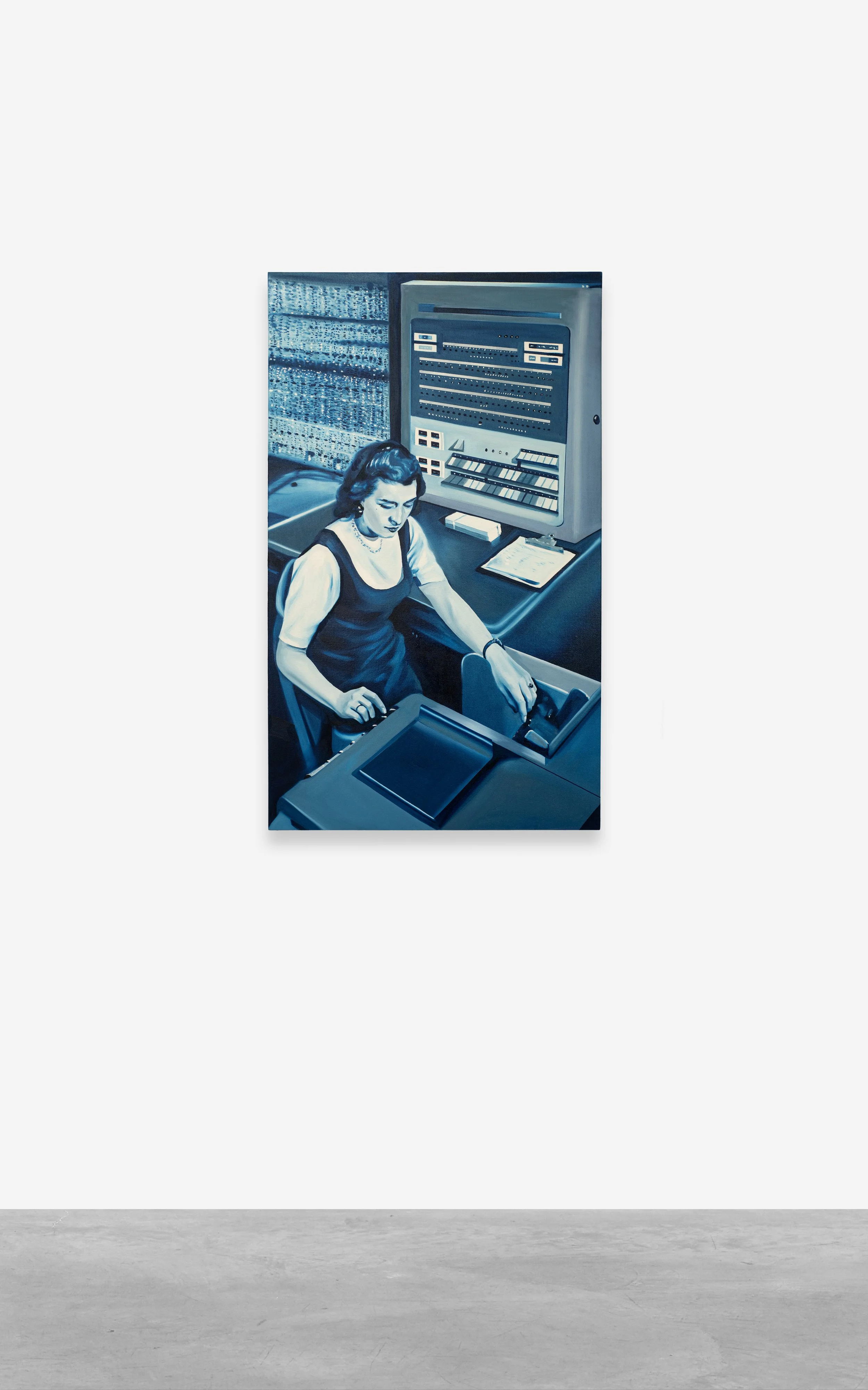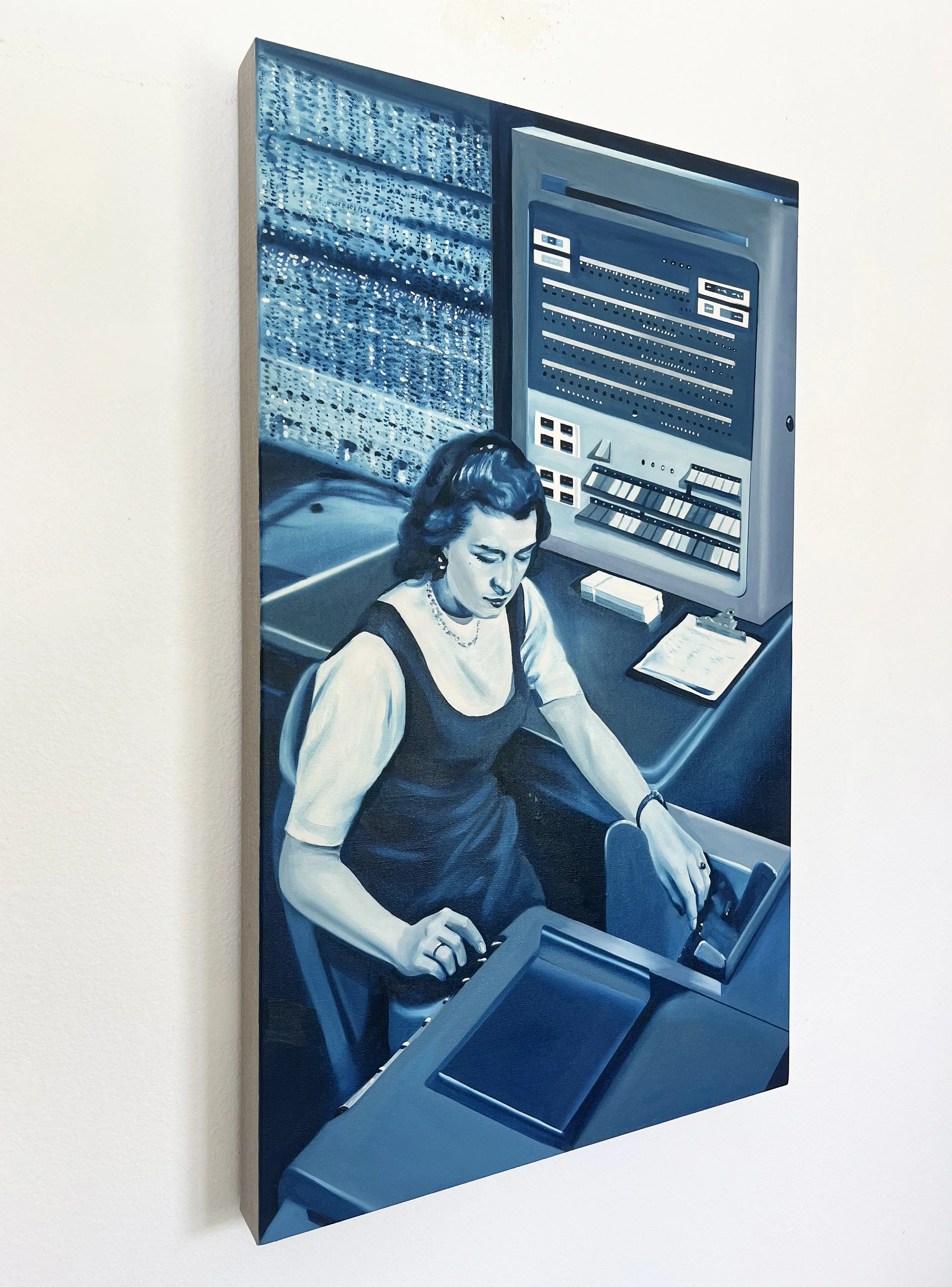The Binary Dream, 2024
The Binary Dream, 2024
Oil on linen
76 x 46 cm (30 x 18 in)
The Binary Dream (2024) delves into the historical and symbolic significance of the IBM 704 electronic data processing machine in scientific research. Inspired by a photograph of a female NASA employee using this groundbreaking computer, the artwork juxtaposes the human figure with the imposing machine, emphasizing the symbiotic relationship between human intellect and technological innovation. It captures a pivotal moment in technological advancement and its application in aerospace research. Introduced in the 1950s, the IBM 704 played a crucial role in early computational science, executing complex calculations at unprecedented speeds. It became an indispensable tool for NASA and other research institutions, serving as a forerunner to modern computing and the AI revolution. Its large-scale computational capabilities laid the foundation for sophisticated algorithms and computer systems that underpin today’s artificial intelligence technology. The Binary Dream highlights the historical significance of the IBM 704, celebrating its transformative impact in ushering humanity into a new era of discovery and exploration—one that ultimately paved the way for the digital age and the ongoing AI revolution.
Q: Your work The Binary Dream (2024) depicts a scene from the early history of computing. Could you share the background and inspiration behind this piece?
Tan Mu: This work draws inspiration from a pivotal moment in the history of computing, highlighting the transformative impact of the IBM 704 on scientific progress. Its large-scale computational power laid the foundation for the development of complex algorithms and computing systems, which now form the backbone of AI technology. The scene in the painting is based on a historical photograph capturing NASA’s early use of IBM computers for complex calculations. Beyond showcasing computing technology of that era, the photograph also reflects the crucial contributions of women in the field. Through this work, I seek to reflect on the evolution of computing while emphasizing the indispensable role of women in technological advancements.
Q: You mentioned the female figures in the image. Could you elaborate on their significance?
Tan Mu: Women played a fundamental role in the early computing industry, particularly in data input and complex calculations. The female operator in this historical photograph serves as a testament to this legacy. By depicting this scene, I aim to acknowledge and preserve the contributions of women in the early development of computing. My focus on female roles in technology runs through many of my works, echoing pieces like The Note G (2022) and Punched Card 1 (2022). This remains an open research direction for me—I intend to further explore the intersections of women and technology through future works. This exploration is not just a retrospective look at history but also a forward-looking inquiry, using art as a medium to document these crucial moments and provide future audiences with a space for reflection.
Q: Why did you choose a monochromatic blue palette for this piece?
Tan Mu: The original archival photograph was in black and white, and I initially experimented with AI-generated colorization to restore its authentic hues. Some versions were remarkably faithful to reality, yet in the end, I chose to express it through a monochromatic blue painting. While AI aims to reconstruct the “real,” I wanted to disrupt this illusion of restoration. The blue palette brings the image closer to the world of computing—monochromatic and structured—yet layered with human labor, imagination, and desire. Blue is IBM’s color; it is Big Blue—a symbol of the rationality and authority of early computing industries. From the IBM 704 to Deep Blue, this color represents not only the logic and computational power of machines but also the sense of detachment that technology can evoke. Through this monochromatic treatment, I sought to immerse the scene in a stream of data, transforming it into a memory—stored, encoded, and, in some ways, reshaped by the machine itself. At the same time, blue carries a temporal quality. It lends the historical image a sense of a “future past”—a scene that is both rooted in its original era and reinterpreted through a contemporary lens. This abstraction strips the photograph of its specific historical context, allowing it to transcend a singular moment and become part of an ongoing contemplation of technological progress. In this work, blue is more than just an IBM reference; it is the color of the computing age, the visual essence of The Binary Dream.
Q: The women in the painting are shown operating early computing equipment. How do you view the contrast between their interaction with computers and modern computing practices?
Tan Mu: The interaction depicted in the painting starkly contrasts with the way we engage with computers today. Early computers required extensive physical manipulation—buttons, switches, and punch card inputs—demanding a deep technical understanding. In contrast, modern computing has largely moved towards a post-keyboard era, with virtual interfaces and automation making interaction more intuitive and seamless. This shift has not only transformed our habits of use but also reshaped how we perceive, comprehend, and engage with technology.
Q: How does this piece connect to your broader body of work?
Tan Mu: This piece is part of my ongoing exploration of computing history and its intersection with human agency, connecting with works like DEC’s PDP-10 (2021) and Checkmate (2022). The blue-toned palette in this work also resonates with my earlier pieces, such as Quantum Computer (2020) and Checkmate (2022), where I delved into the aesthetics of computational systems. These works share a visual language that reflects the cold precision and structured linearity of technology, while also hinting at the human labor and imagination behind it. This continuity in my practice deepens my inquiry into how technology continues to shape—and be shaped by—our world.








